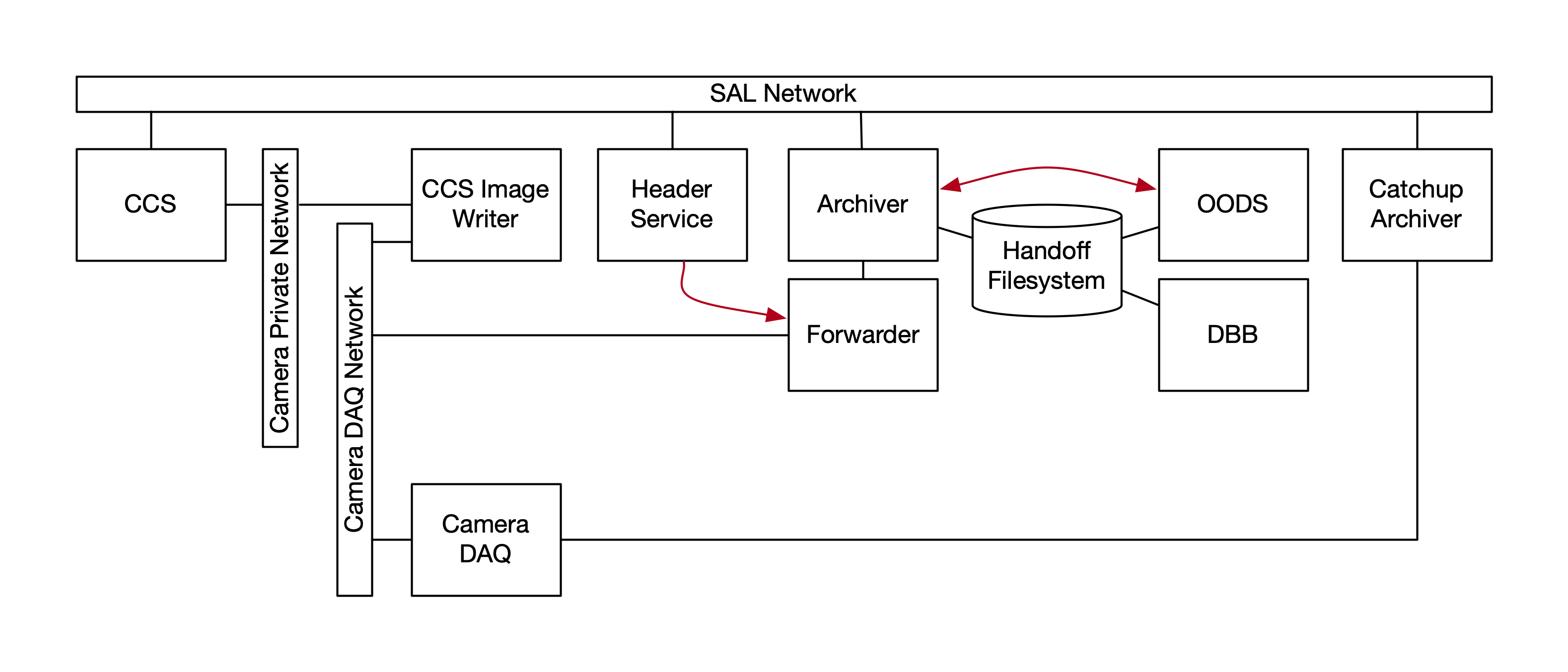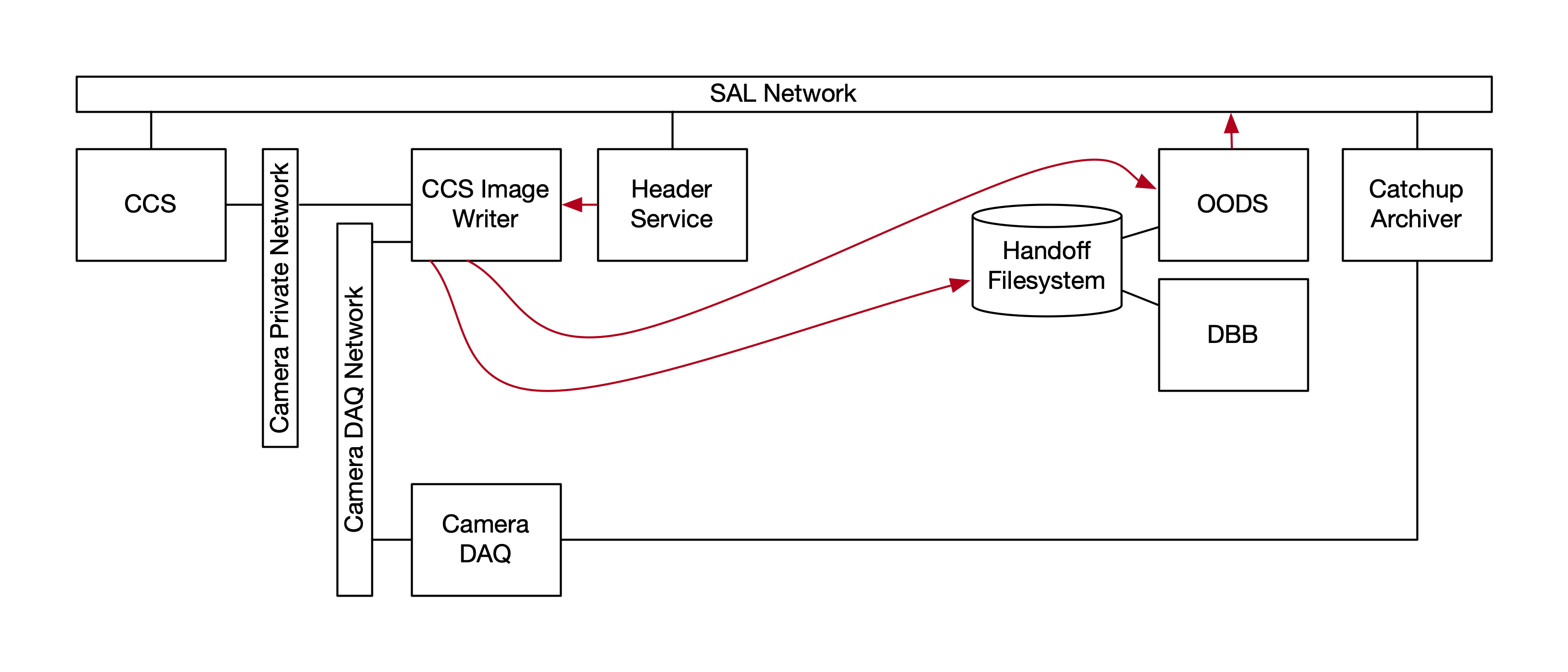1 Current Status¶
Now that crosstalk removal has been descoped from the Camera DAQ, there is only one version of the pixel image that can be and needs to be retrieved, rather than two. There are multiple destinations for this image:
- Camera Diagnostic Cluster for automated visualization and rapid analysis
- Active Optics System (AOS) for wavefront sensors only
- Observatory Operations Data Service (OODS) for automated and ad hoc (including human-driven) rapid analysis
- Data Backbone (DBB) for long-term reliable archival
- For most science and possibly calibration images, Prompt Processing for execution of automated processing pipelines (primarily the Alert Production).
The first four of these are located in Chile at either the Summit or Base. The Prompt Processing systems are located at the LSST Data Facility (LDF), requiring transfer of the pixels over the international network. The desired latency for all of these is generally “as rapid as possible”, with the exception of the DBB, which has up to 24 hours. The DBB also transfers data over the international network, but more slowly.
The first four of these are expecting to persist the pixel data as FITS files in RAM disk or persistent file storage (e.g. GPFS); as a result, it makes sense to do the same for Prompt Processing as well, though care should be taken to minimize latencies in order to avoid delaying alert generation.
All of these need to ingest the image files into a Data Butler repository to enable pipeline code to access the images using butler.get().
It is currently expected that these would be separate Butler repos.
The data ID used for the Butler should include either the image name or group ID and image (“snap”) number as well as the raft and detector/CCD identifiers.
Each system needs to send an event to indicate that the image has been ingested and is thus available to pipelines.
The current baseline, as implemented for LATISS, has an image writer component of the Camera Control System (CCS) writing to the Camera Diagnostic Cluster. Another instance of this image writer is intended to be configured and deployed for the AOS. The OODS and DBB are fed by the DM Archiver and Forwarders, which are a separate image retrieval and writing system. Prompt Processing has not yet been implemented, but it is supposed to use another instance of the Forwarders. In addition, a Catch-Up Archiver is meant to feed the DBB with images that were otherwise missed, including those taken during a Summit-to-Base network outage.
An independent Header Service retrieves image metadata from events and telemetry, writing a single metadata object for each image that can be used by any image writer.

Figure 1 The image writing system as currently baselined (somewhat simplified). The red arrows represent image-completion messaging from the Archiver to the OODS and “header” metadata transfer from the Header Service to the Forwarder (via the Large File Annex).
2 Design Proposal¶
We propose to combine and simplify some of these components.
2.1 CCS-Based Image and Metadata Writing¶
Image writing will be performed exclusively by the CCS image writer code. There will be one instance for CCS and DM uses. We will attempt to use the same instance for AOS uses, but it may be necessary to have a separate instance for this case. Note that guiders in guiding mode are a separate case and not in the scope of this document.
The CCS software will listen for Header Service large file object available events and merge that metadata with the pixels in the files that it writes.
This reduces the number of code bases that need to be supported, saving development effort. It would remove two clients from the DAQ (Forwarder and Prompt Processing Forwarder). It would remove the need for any DAQ clients to live at the Base, thereby removing the need for DAQ networking to extend over the DWDM.[1] Since the CCS is absolutely necessary for image-taking, it would remove the possibility of images being taken with the Archiver or Prompt Processing disabled. (Such images would eventually be retrieved by the Catch-Up Archiver, but they would be at least delayed for Prompt Processing purposes.) It eliminates the current duplication of images and resultant confusion. It ensures that engineering images taken under CCS control are captured the same way as images taken under OCS control (though possibly with less metadata).
| [1] | DWDM stands for dense wavelength-division multiplexing, a way of using a single optical fiber to provide multiple independent Layer 2 network channels. DAQ networking requires a direct, unrouted Layer 2 connection between DAQ and client. These connections have been tested, but they are potentially more fragile due to the long distance and lower-level protocols involved. In this proposal, outbound traffic from the image writer is over Layer 3 TCP/IP network connections that can be routed. |

Figure 2 The image writing system as proposed. The Archiver and Forwarder are removed. The Header Service metadata goes to the CCS Image Writer. Image-completion messages go from the CCS Image Writer to the OODS. Images are copied to the Handoff Filesystem.
2.2 Post-Writing Commands¶
To enable transfer of the pixel images to the systems that need them, the CCS image writing software will be enhanced to accept commands or scripts that can be executed once an image and its metadata has been written successfully. These commands will be configured into the CCS software by specifying a destination name, the command, an opaque parameter string, and a priority order. This configuration information will be published in SAL messasges as part of the CCS configuration.
After an image is written, all commands will be executed on that image, in priority order. Commands should be executed in parallel, but it should be possible to limit the number of commands being executed at the same time at the cost of increased latency. Such throttling may be useful to limit network bandwidth usage.
Any system software packages and authentication information required by the available commands, as well as the software for the commands themselves, will be specified as part of the deployment environment.
Each command will be given a first argument consisting of the filename for the image, which will include the image name, including the observation day (date in the UTC-12 timezone) and the image sequence number, as well as the raft and sensor of the image. Each command will also be given a second argument consisting of the opaque string configured for that command.
On completion, each command must provide exit status. The CCS software will capture this exit status, and, if non-zero, the contents of the standard error stream from the command. It will then arrange to generate a SAL event indicating that the command completed, containing:
- The destination name
- The image obsid
- The sensor corresponding to the file (e.g. R22S01)
- The exit status
- The standard error output if the exit status is non-zero
Occasional failures of this command mechanism are to be expected and are not fatal. In particular, failure of a command will not be a reason to place the CCS subsystem into fault state. All images that are not processed by this mechanism will be retrieved by the Catch-Up Archiver instead.
If a command runs for too long, specified by a configurable timeout, it should be killed and treated as having failed. Commands will not be retried on failure.
When the CCS is being shut down, all commands in flight may be killed. When the CCS restarts, any files discovered that did not have all commands executed may be ignored.
This facility can easily be used to copy files over networks to the Prompt Processing Distributors at the LDF and the OODS (whether at the Summit or Base). If messages are needed to trigger the OODS or other components, the sending commands can be appended to the copy commands in a script.
2.3 Catch-Up Archiver¶
An independent Catch-Up Archiver will be needed in any case. Neither the DM Archiver/Forwarder nor the CCS image writer can be considered 100% reliable in terms of capturing all science images. The Catch-Up Archiver will reuse code from the CCS image handler for catalog enumeration, pixel manipulation, and file output, but it is a separate CSC that interfaces to the DBB to know which images have already been archived and to ingest images that it writes.
The Catch-Up Archiver can live at the Summit. If 3 machines with 1 GB/sec (over 10Gb Ethernet) inbound and outbound network bandwidth are allocated to the Catch-Up Archiver, it should be possible to copy data to the Base at the rate of one 12 GB (uncompressed, even) image per 4 seconds, 4X the normal image capture rate, which is at most one image per 17 seconds. This is sufficient to empty the buffer after even a long outage.
3 Transition Plan and Personnel¶
The first steps in a transition to this design would be:
- Have the image writer get metadata from the Header Service. This is already planned, but it would be critical to get this in place ASAP.
- Implement the post-capture command facility. At this point, minimal functionality would be available for LATISS and test stands, including ComCam.
While Tony Johnson (the prime CCS author) is quite busy with LATISS commissioning, ComCam testing, and LSSTCam integration and testing, at least Steve Pietrowicz from NCSA could help with the Java-based aspects of this transition.
3.1 Further Additions¶
The following additions would need to be made after the initial transition:
- Sufficient Summit-located compute resources, including hot spare nodes and network bandwidth, would need to be devoted to the Camera Diagnostic Cluster in order for it to also serve as the source of OODS, DBB, and Prompt Processing data.
- The CCS image writer code would need to be enhanced to add robustness and fault tolerance. As currently written, it will fail to capture data if a node fails during or between image captures, and it must be manually reconfigured to recover to normal operation or else it continues to fail to capture data. The mechanisms used by the current DM Archiver should serve as a reference, but they would have to be ported to the Java environment of the CCS.
- The CCS image writer code needs to be able to interface with the Catch-Up Archiver. The ability to retrieve images by name from a catalog listing is planned, but it may need to be implemented sooner and as part of a new CSC.
4 Header Service¶
Another possible simplification is to integrate the Header Service with the CCS image writer code. This has potential difficulties:
- If there is a separate instance of the CCS image writer for the AOS, it may be difficult to keep these instances in sync or to keep multiple metadata objects separate.
- Porting the current SAL-heavy Python code to Java may not be easy.
Nevertheless, this should be considered down the road, again because having the CCS perform this function can help ensure that it happens for every image and moves the metadata capture point close to the authoritative source for most of it.